As a person with celiac disease, finding gluten-free options is crucial. When I first heard about Pad Thai, I wondered, “Is Pad Thai gluten free?” After doing research and experimenting in the kitchen, I discovered that Pad Thai can be made gluten-free by substituting ingredients and following certain guidelines. In this article, I will share my findings and provide a comprehensive guide on Is Pad Thai gluten free.
See also: Pad See Ew vs Drunken Noodles
What is gluten in pad Thai?
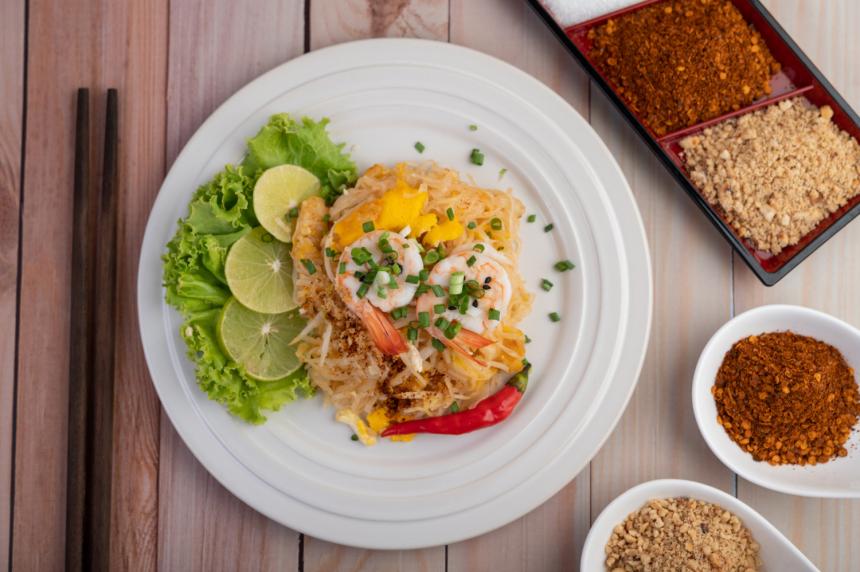
Pad Thai is a popular Thai dish made with stir-fried rice noodles, eggs, vegetables, peanuts, and a sweet and savory sauce. However, the sauce may contain soy sauce or other ingredients that contain gluten, which is a protein found in wheat, barley, and rye.
Gluten can cause digestive problems for people with celiac disease or gluten intolerance. Despite this, Pad Thai has become popular worldwide for its delicious flavors and versatility. The dish originated in Thailand during World War II and has since evolved to include various regional and international variations.
What is gluten?
Gluten is a protein found in wheat, barley, rye, and related grains. It gives dough its elasticity and helps it rise during baking. While gluten is safe for most people, it can cause digestive problems for individuals with celiac disease or gluten intolerance.
In these cases, the immune system mistakenly attacks gluten as if it were a harmful substance, leading to inflammation and damage to the small intestine.
Symptoms may include abdominal pain, bloating, diarrhea, and fatigue. Avoiding gluten is crucial for those with celiac disease or gluten intolerance to prevent long-term health complications.
Gluten-free Pad Thai recipe
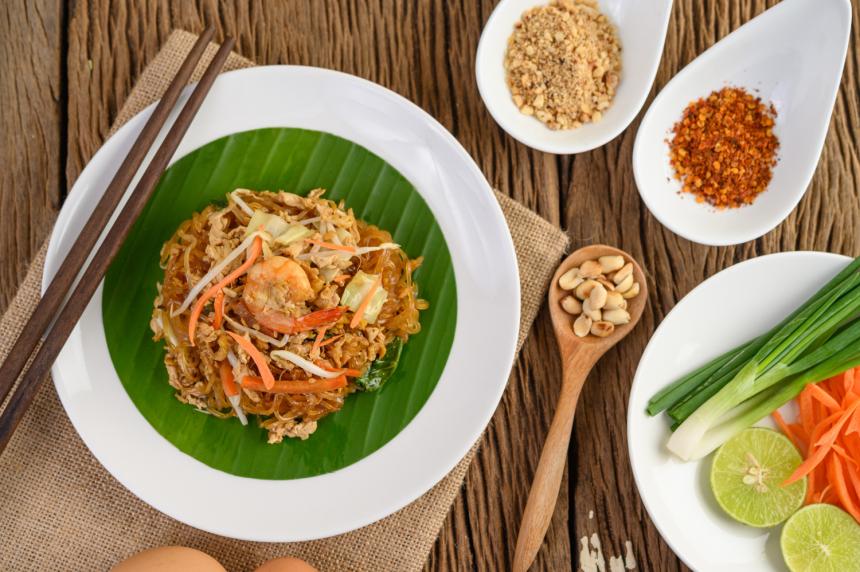
Pad Thai recipe serves 4 and can easily be adjusted to serve more or fewer people.
Cooking note
- Yield: 4 servings
- Prep Time: 15 minutes
- Cook Time: 15 minutes
- Total Time: 30 minutes
- Course: Main Dish
- Cuisine: Thai
- Equipment:
- Wok or large skillet
- Mixing bowl
- Whisk
- Tongs or spatula
- Sharp knife
Ingredient
- 8 oz. rice noodles
- 2 tbsp. vegetable oil
- 1 lb. chicken breast, sliced thinly
- 3 garlic cloves, minced
- 2 eggs, beaten
- 2 cups bean sprouts
- 1 cup sliced carrots
- 1 cup sliced bell peppers
- 1/4 cup chopped green onions
- 1/4 cup chopped roasted peanuts
- Lime wedges, for serving
Sauce
- 1/4 cup gluten-free soy sauce or tamari
- 2 tbsp. brown sugar
- 2 tbsp. rice vinegar
- 2 tbsp. ketchup
- 1 tbsp. fish sauce
- 1/4 tsp. red pepper flakes
Instructions
- Soak the rice noodles in a bowl of hot water for 10–15 minutes, or until they are soft and pliable.
- In a small mixing bowl, whisk together the ingredients for the sauce and set aside.
- Heat the vegetable oil in a wok or large skillet over medium-high heat. Add the sliced chicken and garlic and stir-fry for 2-3 minutes, or until the chicken is cooked through.
- Push the chicken to one side of the wok and add the beaten eggs to the other side. Scramble the eggs with a spatula until they are fully cooked.
- Add the bean sprouts, carrots, and bell peppers to the wok and stir-fry for 2–3 minutes, or until the vegetables are slightly softened.
- Drain the rice noodles and add them to the wok, along with the chopped green onions and peanuts.
- Pour the sauce over the noodle mixture and toss everything together until well-coated.
- Serve immediately with lime wedges on the side.
Is pad Thai gluten free?
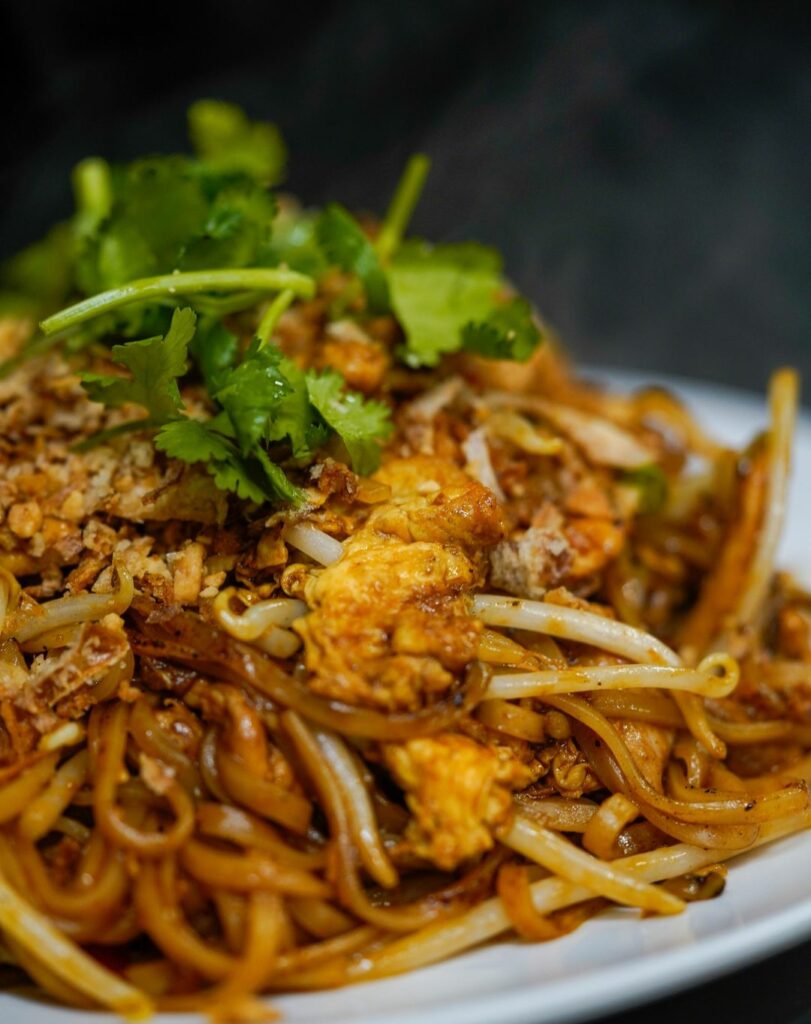
The answer to whether Pad Thai is gluten-free depends on the ingredients and preparation methods used. Traditional Pad Thai recipes typically contain gluten in the form of soy sauce, which is made with wheat.
However, there are gluten-free alternatives available, such as tamari or coconut aminos. Additionally, rice noodles, the main ingredient in Pad Thai, are naturally gluten-free.
The ingredients in Pad Thai can vary depending on the recipe and the restaurant. To determine if the ingredients are gluten-free, it’s important to analyze each type of material. Here are some common ingredients in Pad Thai and whether they are gluten-free:
Rice noodles
Rice noodles are naturally gluten-free and a common ingredient in Pad Thai.
Vegetables
Most vegetables used in Pad Thai are gluten-free, including carrots, bell peppers, bean sprouts, and green onions. However, it’s important to avoid using vegetables that are breaded or fried with wheat flour.
Protein
Chicken, shrimp, and tofu are common sources of protein used in Pad Thai and are naturally gluten-free. However, some restaurants may use a marinade or breading that contains gluten, so it’s important to confirm with the chef or server.
Sauce
Traditional Pad Thai sauce contains soy sauce, which is made with wheat and contains gluten. However, there are gluten-free soy sauce alternatives, such as tamari or coconut aminos, that can be used to make a gluten-free Pad Thai sauce.
Garnishes
Garnishes like peanuts and cilantro are naturally gluten-free. However, some packaged roasted peanuts may contain gluten, so it’s important to check the label.
The ingredients in Pad Thai can be gluten-free as long as you choose the right ingredients and sauces. It’s important to read labels carefully and confirm with the chef or server if dining out to ensure that the dish is truly gluten-free.
Are pad Thai noodles gluten free?
Pad Thai noodles are traditionally made with rice flour, which is naturally gluten-free. Therefore, Pad Thai noodles are considered gluten-free.
However, it’s important to check the ingredients in the sauce used in Pad Thai, as some sauces may contain soy sauce, which is made with wheat and contains gluten.
If you have celiac disease or gluten intolerance, it’s crucial to ensure that all ingredients used in the Pad Thai dish are gluten-free to avoid any potential health issues.
What are alternatives Pad Thai gluten-free?
There are several gluten-free alternatives to traditional ingredients in Pad Thai that can make the dish safe for people with celiac disease or gluten intolerance. Some alternatives to consider include:
- Tamari or coconut aminos instead of soy sauce
- Rice noodles or zucchini noodles instead of wheat noodles
- Tapioca starch or cornstarch instead of wheat flour as a thickener for the sauce
- Gluten-free oyster sauce or hoisin sauce as a substitute for traditional sauces
What are the health benefits and risks of gluten free Pad Thai?
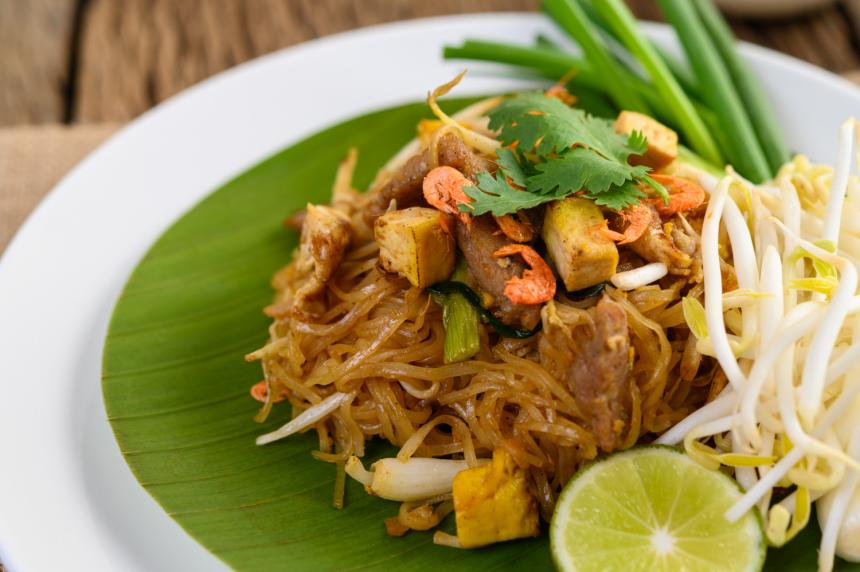
Health benefits
Pad Thai can offer several health benefits, including:
- Balanced nutrition: Pad Thai typically contains a variety of vegetables, protein, and carbohydrates, making it a well-rounded meal.
- Antioxidants: The dish often includes ingredients like garlic, onions, and peanuts, which are rich in antioxidants.
- Low-fat option: If prepared with lean protein and minimal oil, Pad Thai can be a relatively low-fat meal option.
Risks associated
However, there are also potential risks associated with eating Pad Thai:
- High calorie content: Some Pad Thai dishes can be high in calories due to added sugars and oils.
- High sodium content: Traditional Pad Thai sauce is often high in sodium, which can be harmful to people with high blood pressure or other health conditions.
- Gluten intolerance: For individuals with celiac disease or gluten intolerance, eating Pad Thai with traditional wheat-based noodles and soy sauce can cause digestive problems and inflammation.
Common misconceptions
There are several common misconceptions about gluten-free Pad Thai that may lead to confusion or misinformation. Here are a few myths about Pad Thai that can be debunked:
- Myth: All Pad Thai is gluten-free.
- Reality: Traditional Pad Thai sauce is often made with soy sauce, which contains gluten. Therefore, not all Pad Thai is gluten-free, and it’s important to check the ingredients before consuming.
- Myth: Gluten-free Pad Thai is not as flavorful.
- Reality: Gluten-free Pad Thai can be just as flavorful as the traditional version, with the right ingredients and preparation methods. In fact, some people may not even notice a difference in taste.
- Myth: Gluten-free Pad Thai is always a healthy option.
- Reality: While gluten-free Pad Thai can be a healthier option than the traditional version, it’s still important to consider factors such as portion sizes, added sugars and oils, and ingredient quality to make it a truly healthy option.
Tips for making gluten free Pad Thai
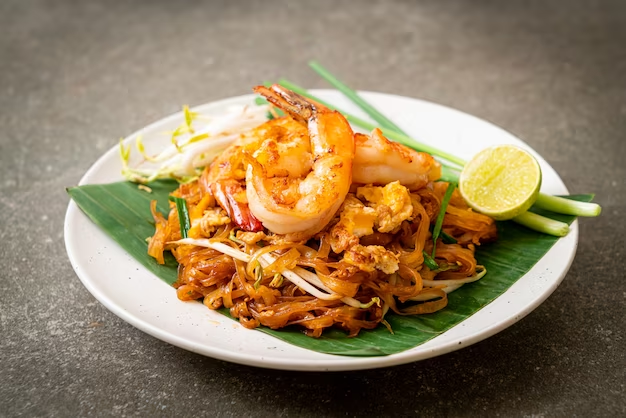
Here are some tips for making gluten-free Pad Thai:
- Use gluten-free noodles: Choose rice noodles or other gluten-free noodle options to ensure that your Pad Thai is safe for those with celiac disease or gluten intolerance.
- Choose gluten-free sauces: Opt for gluten-free soy sauce alternatives, such as tamari or coconut aminos, to create a flavorful Pad Thai sauce without gluten.
- Check ingredient labels: Make sure all ingredients used in your Pad Thai recipe are gluten-free and do not contain wheat, barley, or rye.
- Avoid cross-contamination: If cooking in a shared kitchen, make sure to use separate cooking utensils, pans, and cutting boards to avoid cross-contamination with gluten-containing foods.
- Load up on veggies: Add plenty of fresh vegetables to your Pad Thai recipe for added nutrients and flavor.
- Use lean protein sources: Choose lean protein sources, such as chicken, shrimp, or tofu, to keep your Pad Thai low in fat and high in protein.
- Control portion sizes: Pad Thai can be high in calories, so it’s important to control portion sizes and avoid overindulging.
Related: Pad See Ew Calories: Understanding the Basics
How much is pad thai?
The cost of Pad Thai can vary depending on the restaurant or location. In general, Pad Thai can cost anywhere from $10 to $20 or more, depending on the ingredients, portion size, and other factors.
Homemade Pad Thai can be more cost-effective and allows for greater control over the ingredients and preparation methods.
FAQs
Can I find gluten-free pad Thai in restaurants?
You may be able to find gluten-free Pad Thai in restaurants that offer gluten-free options. However, it’s important to ask about the ingredients and preparation methods to ensure that the dish is truly gluten-free.
How can I tell if my pad Thai is gluten-free?
To tell if your Pad Thai is gluten-free, check the ingredients in the sauce and noodles. If wheat-based ingredients are not listed, and the noodles are made from rice or other gluten-free sources, then the dish is likely gluten-free.
However, it’s important to ask the server or chef to confirm that there is no cross-contamination during the cooking process. If you have celiac disease or gluten intolerance, it’s important to be vigilant and ask about ingredients and preparation methods to avoid any potential health issues.
Can I still enjoy pad Thai on a gluten-free diet?
Yes, you can still enjoy Pad Thai on a gluten-free diet by using gluten-free ingredients and following proper preparation methods.
Are there any gluten-free alternatives for pad Thai sauce?
Some gluten-free alternatives for traditional Pad Thai sauce include tamari or coconut aminos instead of soy sauce, and tapioca starch or cornstarch as a thickener instead of wheat flour.
Additionally, rice noodles are a gluten-free alternative to wheat noodles in Pad Thai. By using these alternatives and being mindful of ingredient labels and cross-contamination risks, you can enjoy a delicious and safe gluten-free Pad Thai.
Is there a difference in taste between gluten-free Pad Thai and traditional Pad Thai?
There may be a slight difference in taste between gluten-free Pad Thai and traditional Pad Thai, but with the right ingredients and preparation methods, it can still be equally delicious. Some people may not even notice a difference in taste at all.
Rice noodles and gluten-free sauces, such as tamari or coconut aminos, can be used as alternatives to traditional wheat-based noodles and soy sauce, respectively. By using fresh, high-quality ingredients and properly seasoning your dish, you can create a flavorful gluten-free Pad Thai that satisfies your taste buds.
How can I avoid cross-contamination when making gluten-free pad Thai?
To avoid cross-contamination when making gluten-free Pad Thai, it’s important to use separate utensils, pans, and cutting boards for gluten-free ingredients. Clean all cooking surfaces thoroughly and use fresh oil and seasonings to avoid any potential gluten contamination.
Additionally, it’s a good idea to label gluten-free ingredients and designate specific cooking areas for gluten-free preparation to prevent any accidental mix-ups.
Can I freeze gluten-free pad Thai?
Yes, you can freeze gluten-free Pad Thai for later consumption. To freeze, let the dish cool completely, then transfer it to an airtight container or freezer bag and freeze for up to 1–2 months. To thaw, leave the container in the fridge overnight and reheat as desired.
What is the shelf life of gluten-free pad Thai?
The shelf life of gluten-free Pad Thai depends on the ingredients used and the storage conditions. Generally, when stored in an airtight container in the refrigerator, gluten-free Pad Thai can last for up to 3-4 days. However, it’s important to monitor the quality and freshness of the dish and avoid consuming it if it appears or smells spoiled.
Is it safe to reheat gluten free pad Thai?
It is safe to reheat gluten-free Pad Thai, but it’s important to do so properly to avoid overcooking or drying out the dish. To reheat, add a small amount of water or broth to the Pad Thai to help steam and rehydrate the noodles.
Alternatively, you can microwave the dish in short intervals, stirring frequently to ensure even heating. Reheat until the Pad Thai is hot and reaches a safe temperature of at least 165°F to avoid foodborne illness.
Conclusion
Is Pad Thai gluten free? The answer is yes, with the right knowledge and preparation. Pad Thai can be gluten-free if prepared with the right ingredients and techniques. Whether you’re eating out or cooking at home, it’s important to understand what goes into your Pad Thai dish and how to avoid cross-contamination. Despite misconceptions about gluten-free options, Pad Thai can be a delicious and healthy meal for those with celiac disease or gluten intolerance.
By following the tips and guidelines in this article, you can enjoy Pad Thai without worrying about gluten. So go ahead and indulge in this beloved dish!